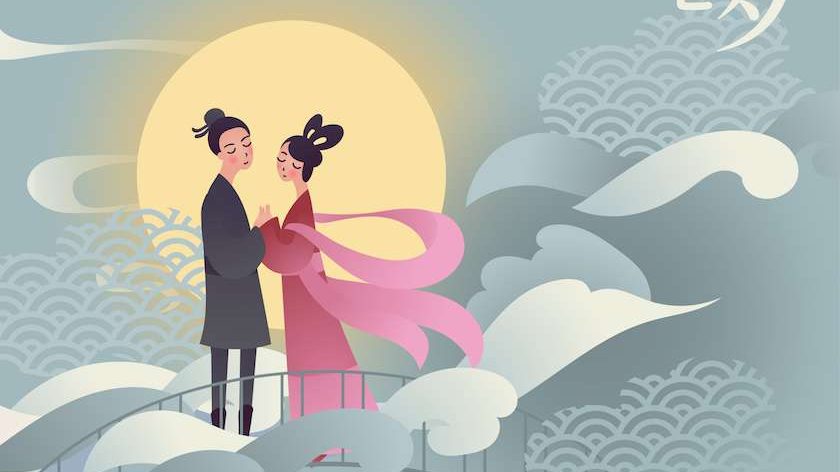Though it is mostly an irreligious country, seemingly untroubled by matters of the hereafter, Japan is over-run with festivals and holidays dedicated to the Buddhist and Shinto gods.
According to the most recent available data, approximately 35% of Japanese people claim Buddhism as their religion, while around 3-4% claim Shinto or associated folk religions. Only 1-2% of Japanese claim Christianity as their religion, and only around half of Japanese Christians are Catholic.
However, despite the minuscule portion of the general population that actively affiliate themselves with Shinto temples and claim to abide by the Shinto worldview, around 70% of Japanese report participating in some annual Shinto ceremonies.
These ceremonies include Tanabata, the star festival, wherein families visit temples and shrines in order to write wishes on slips of paper and hang them from bamboo plants.
The festival’s mythology claims that the day is the annual meeting of two gods, one male and one female, who are separated lovers – Orihime and Hikoboshi. Tradition states that these two spirits are separated by the Milky Way, and that when there is no rain on the seventh day of the seventh month of the year, the two can be together.
The celebration is so widespread that even Tokyo Disneyland performs a special event for the day, casting Mickey Mouse and Minnie Mouse as the separated god and goddess in love.
Another example of common Shinto-influenced celebrations is Obon, a week-long festival far more solemn than the joyful, carefree festivals of spring and early summer.
Obon is a week-long holiday dedicated to deceased ancestors. Many families come together from across the country to meet at ancestral homes, cleaning graves and leave offerings for the spirits ancestors, including sake and rice.
But are these Shinto holidays off-limits to Catholics?
“A few years ago, the Committee on Inter-religious Dialogue of the Catholic Bishops’ Conference of Japan issued a guideline on this matter,” Archbishop Isao Kikuchi told CNA, ahead of Pope Francis' Nov. 23-26 visit to Japan.
“In the case of community traditions, there is no problem participating in the event.”
That’s because, according to the committee’s findings, these festivals often carry no spiritual weight for participants.
“In many cases, members of the community do not find religious implications for these events. But rather, they see it as an opportunity to strengthen the community spirit of the neighborhood.”
These Shinto “community events” can perhaps best be compared to, for instance, Halloween in the United States.
While for some Christians, Catholics included, All Saints Day and All Souls Day are very real and religiously charged days on the liturgical calendar, many people celebrate the holiday of Halloween with no awareness of its actual spiritual significance.
The reality of Shinto celebrations (and to a lesser degree Buddhist celebrations) in Japan are largely the same.
However, Archbishop Kikuchi made one clear distinction on the subject of these holidays.
“It is not recommended to actively participate in worship at places such as in a Shinto shrine.”
The Japanese bishops have warned against certain forms of participation in these community festivals that still swerve too close to expressions of real religious devotion. While many visitors to shrines and temples around these times of year are not directly engaging with any religious worship, others can toe the line or fully cross it, the bishops warn.
For example, a common ritual at shrines during the holidays is to toss money into the open area in front of the main worship area, clap thunderously to scare away evil spirits, then clasp your hands and close your eyes in prayer. While there can be debate over what exactly the average Japanese means when they say they “pray” during these events, the practice is still universally condemned for Catholics in the country.
Additionally, a Shinto totem known as a mikoshi is often carried through the streets on festival days. A mikoshi is considered by Shinto believers to be a portable vehicle through which to transport gods and spirits from one shrine to another.
These miniature shrines are carried on the shoulders of dozens of town volunteers, each shouldering a small portion of the very heavy religious object. The transport of mikoshi often brings with it parades, chants, and religious dances.
Mikoshi, too, are strictly banned for Catholics.
The bishops do not see these universally important days in the Japanese calendar as obstacles to evangelization. Instead, they want to break them down and reshape them into something Catholics can use for their own spiritual lives.
And most importantly, it seems that they want to keep Japanese Catholics from being alienated entirely from Japanese life.
“In addition, many parishes have incorporated in their liturgical calendar Japanese customs having no religious character, such as the blessing of children aged 7, 5 and 3,” the archbishop explained.
A few Catholic parishes have even begun to shift their celebrations of the dead, usually reserved for October and November, to August to match with Obon.
“The Church can […] turn such occasions into opportunities for evangelization,” said Archbishop Kikuchi.

